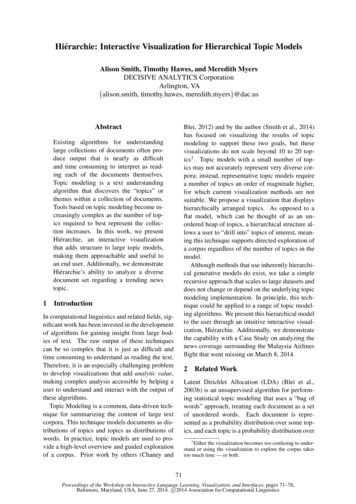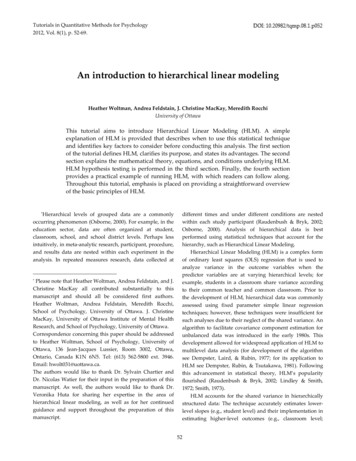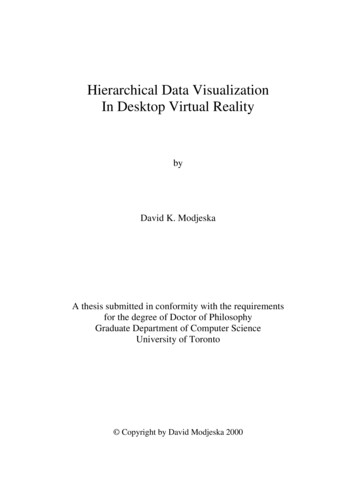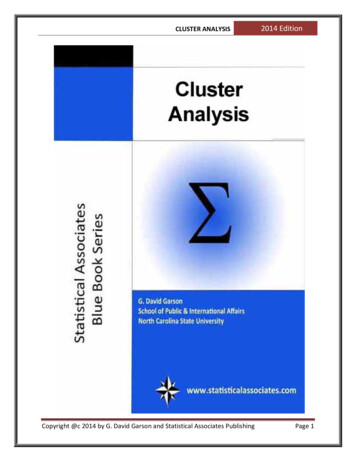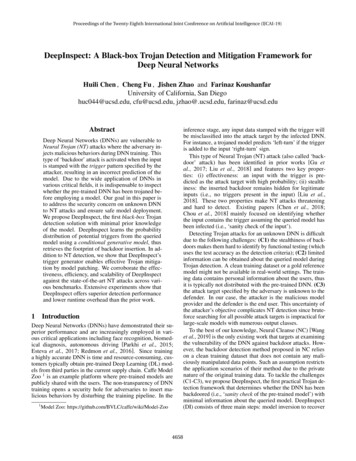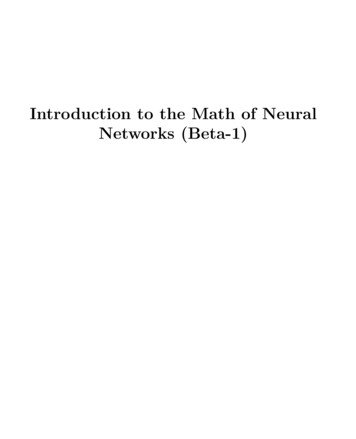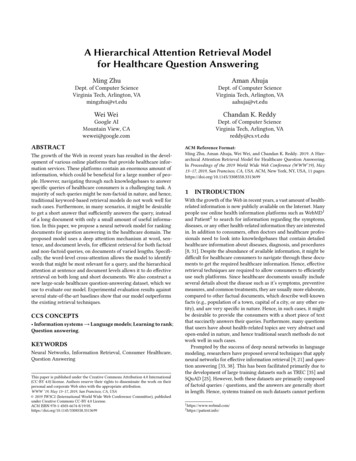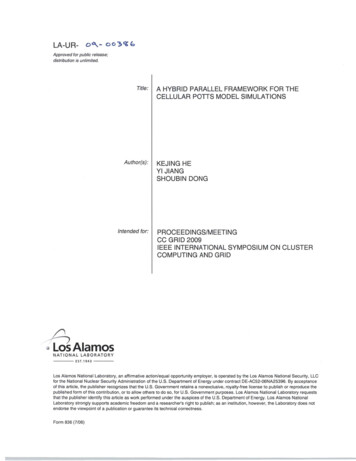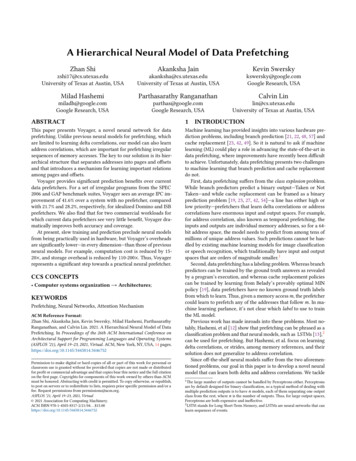
Transcription
A Hierarchical Neural Model of Data PrefetchingZhan ShiAkanksha JainKevin Swerskyzshi17@cs.utexas.eduUniversity of Texas at Austin, USAakanksha@cs.utexas.eduUniversity of Texas at Austin, USAkswersky@google.comGoogle Research, USAMilad HashemiParthasarathy RanganathanCalvin Linmiladh@google.comGoogle Research, USAparthas@google.comGoogle Research, USAlin@cs.utexas.eduUniversity of Texas at Austin, USAABSTRACT1This paper presents Voyager, a novel neural network for dataprefetching. Unlike previous neural models for prefetching, whichare limited to learning delta correlations, our model can also learnaddress correlations, which are important for prefetching irregularsequences of memory accesses. The key to our solution is its hierarchical structure that separates addresses into pages and offsetsand that introduces a mechanism for learning important relationsamong pages and offsets.Voyager provides significant prediction benefits over currentdata prefetchers. For a set of irregular programs from the SPEC2006 and GAP benchmark suites, Voyager sees an average IPC improvement of 41.6% over a system with no prefetcher, comparedwith 21.7% and 28.2%, respectively, for idealized Domino and ISBprefetchers. We also find that for two commercial workloads forwhich current data prefetchers see very little benefit, Voyager dramatically improves both accuracy and coverage.At present, slow training and prediction preclude neural modelsfrom being practically used in hardware, but Voyager’s overheadsare significantly lower—in every dimension—than those of previousneural models. For example, computation cost is reduced by 1520 , and storage overhead is reduced by 110-200 . Thus, Voyagerrepresents a significant step towards a practical neural prefetcher.Machine learning has provided insights into various hardware prediction problems, including branch prediction [21, 22, 48, 57] andcache replacement [23, 42, 49]. So it is natural to ask if machinelearning (ML) could play a role in advancing the state-of-the-art indata prefetching, where improvements have recently been difficultto achieve. Unfortunately, data prefetching presents two challengesto machine learning that branch prediction and cache replacementdo not.First, data prefetching suffers from the class explosion problem.While branch predictors predict a binary output—Taken or NotTaken—and while cache replacement can be framed as a binaryprediction problem [19, 23, 27, 42, 54]—a line has either high orlow priority—prefetchers that learn delta correlations or addresscorrelations have enormous input and output spaces. For example,for address correlation, also known as temporal prefetching, theinputs and outputs are individual memory addresses, so for a 64bit address space, the model needs to predict from among tens ofmillions of unique address values. Such predictions cannot be handled by existing machine learning models for image classificationor speech recognition, which traditionally have input and outputspaces that are orders of magnitude smaller.1Second, data prefetching has a labeling problem. Whereas branchpredictors can be trained by the ground truth answers as revealedby a program’s execution, and whereas cache replacement policiescan be trained by learning from Belady’s provably optimal MINpolicy [19], data prefetchers have no known ground truth labelsfrom which to learn. Thus, given a memory access m, the prefetchercould learn to prefetch any of the addresses that follow m. In machine learning parlance, it’s not clear which label to use to trainthe ML model.Previous work has made inroads into these problems. Most notably, Hashemi, et al [12] show that prefetching can be phrased as aclassification problem and that neural models, such as LSTMs [13],2can be used for prefetching. But Hashemi, et al. focus on learningdelta correlations, or strides, among memory references, and theirsolution does not generalize to address correlation.Since off-the-shelf neural models suffer from the two aforementioned problems, our goal in this paper is to develop a novel neuralmodel that can learn both delta and address correlations. We tackleCCS CONCEPTS Computer systems organization Architectures;KEYWORDSPrefetching, Neural Networks, Attention MechanismACM Reference Format:Zhan Shi, Akanksha Jain, Kevin Swersky, Milad Hashemi, ParthasarathyRanganathan, and Calvin Lin. 2021. A Hierarchical Neural Model of DataPrefetching. In Proceedings of the 26th ACM International Conference onArchitectural Support for Programming Languages and Operating Systems(ASPLOS ’21), April 19–23, 2021, Virtual. ACM, New York, NY, USA, 14 ssion to make digital or hard copies of all or part of this work for personal orclassroom use is granted without fee provided that copies are not made or distributedfor profit or commercial advantage and that copies bear this notice and the full citationon the first page. Copyrights for components of this work owned by others than ACMmust be honored. Abstracting with credit is permitted. To copy otherwise, or republish,to post on servers or to redistribute to lists, requires prior specific permission and/or afee. Request permissions from permissions@acm.org.ASPLOS ’21, April 19–23, 2021, Virtual 2021 Association for Computing Machinery.ACM ISBN 978-1-4503-8317-2/21/04. . . 15.00https://doi.org/10.1145/3445814.34467521 TheINTRODUCTIONlarge number of outputs cannot be handled by Perceptrons either. Perceptronsare by default designed for binary classification, so a typical method of dealing withmultiple prediction outputs is to have n models, each of them separating one outputclass from the rest, where n is the number of outputs. Thus, for large output spaces,Perceptrons are both expensive and ineffective.2 LSTM stands for Long Short-Term Memory, and LSTMs are neural networks that canlearn sequences of events.
ASPLOS ’21, April 19–23, 2021, Virtualthe two problems by developing a novel hierarchical neural network structure that exploits unique properties of data prefetching(described momentarily) that are not found in ML tasks in computervision or natural language processing.To solve the class explosion problem, we decompose addressprediction into two sub-problems, namely, page prediction andoffset prediction. Thus, while a program can have tens of millionsof unique addresses, the total number of unique pages is only in thetens or hundreds of thousands, and the number of unique offsets isfixed at 64.While this decomposition might appear to be both obvious andtrivial, the naive decomposition leads to the offset aliasing problemin which all addresses with the same offset but different pageswill alias with one another. More precisely, different addresseswith the same offset will share the same offset embedding,3 whichlimits the ability of neural networks to learn, because differentdata addresses pull the shared offset embedding towards differentanswers, resulting in poor performance. To address this issue, weuse a novel attention-based embedding layer that allows the pageprediction to provide context for the offset prediction. This contextenables our shared embedding layer to differentiate data addresseswithout needing to learn a unique representation for every dataaddress.To solve the labeling problem, we observe that the problem issimilar to the notion of localization for prefetchers. For example,temporal prefetchers, such as STMS [53] and ISB [18], capture thecorrelation between a pair of addresses, A and B, where A is thetrigger, or input feature, and B is the prediction, or output label.The labeling problem is to find the most correlated output label Bfor the input feature A. In STMS, A and B are consecutive memoryaddresses in the global access stream. In ISB, which uses PC localization [34], A and B are consecutive memory addresses accessedby a common PC. But PC-localization is not always sufficient, forexample, in the presence of data-dependent correlations acrossmultiple PCs. Thus, to explore new forms of localization, we buildinto our neural model a multi-label training scheme that enablesthe model to learn from multiple possible labels. The key idea isthat instead of providing a single ground truth label, the model canlearn the label that is most predictable.While this paper does not yet make neural models practicalfor use in hardware data prefetchers, it shows that it is possibleto advance the state-of-the-art in data prefetching by using superior prefetching algorithms. In particular, this paper makes thefollowing contributions: We advance the state-of-the-art in neural network-basedprefetching by presenting Voyager,4 a neural network modelthat can perform temporal prefetching. Our model uses anovel attention-based embedding layer to solve key challenges that arise from handling the large input and outputspaces of correlation-based prefetchers. We outline the design space of temporal prefetchers by usingthe notion of features and localization, and we show that3 An embedding is an internal representation of input features within a neural network,and an embedding layer learns this representation during training such that featuresthat behave similarly have similar embeddings.4 We name our system after the Voyager space probes, which were launched to extendthe horizon of space exploration with no guarantees of what they would find.Z. Shi, A. Jain, K. Swersky, M. Hashemi, P. Ranganathan, and C. Linneural networks are capable of exploiting rich features, suchas the history of data addresses. We are the first to demonstrate that LSTM-based prefetcherscan outperform existing hardware prefetchers (see Section 2).Using a set of irregular benchmarks, Voyager achieves accuracy/coverage of 79.6%, compared with 57.9% for ISB [18],and Voyager improves IPC over a system with no prefetcherby 41.6%, compared with 28.2% for ISB. More significantly,on Google’s search and ads, two applications that haveproven remarkably resilient against hardware data prefetchers, our model achieves 37.8% and 57.5% accuracy/coverage,respectively, where an idealized version of ISB sees accuracy/coverage of just 13.8% and 26.2%, respectively.Thus, our solution shows that significant headroom stillexists for data prefetching, which is instructive for a problemfor which there is no optimal solution. We also show that Voyager significantly outperforms previous neural prefetchers [12], producing accuracy/coverage of79.6%, compared with Delta-LSTM’s 56.8%, while also significantly reducing overhead in training cost, prediction latency,and storage overhead. For example, Voyager reduces training and prediction cost by 15-20 , and it reduces model sizeby 110-200 . Voyager’s model size is smaller than those ofnon-neural state-of-the-art temporal prefetchers [3, 53, 56].The remainder of this paper is organized as follows. Section 2contrasts our work with both traditional data prefetchers and machine learning-based prefetchers. Section 3 then presents our probabilistic formulation of data prefetching, which sets the stage forthe description of our our new neural prefetcher in Section 4. Wethen present our empirical evaluation in Section 5, before providingconcluding remarks.2RELATED WORKWe now discuss previous work in data prefetching, which canbe described as either rule-based or machine learning-based. Thevast majority of prefetchers are rule-based, which means that theypredict future memory accesses based on pre-determined learningrules.2.1Rule-Based Data PrefetchersMany data prefetchers use rules that target sequential [15, 26, 43]or strided [2, 10, 16, 36, 40] memory accesses. For example, streambuffers [2, 26, 36] confirm a constant stride if some fixed numberof consecutive memory accesses are the same stride apart. Morerecent prefetchers [31, 39] improve upon these ideas by testinga few pre-determined strides to select an offset that provides thebest coverage. Offset-based prefetchers are simple and powerful,but their coverage is limited because they apply a single offset toall accesses. By contrast, Voyager can employ different offsets fordifferent memory references.Instead of predicting constant offsets, another class of prefetchersuses delta correlation to predict recurring delta patterns [35, 41]. Forexample, Nesbit et al.’s PC/DC prefetcher [35] and Shevgoor et al.’sVariable Delta Length Prefetcher predict these patterns by trackingdeltas between consecutive accesses by the same PC. The SignaturePath Prefetcher uses compressed signatures that encapsulate past
A Hierarchical Neural Model of Data Prefetchingaddresses and strides within a page to generate the next stride [28].Voyager is better equipped to predict these delta patterns, as it cantake longer context—potentially spanning multiple spatial regions—to make a stride prediction.Irregular prefetchers move beyond sequential and strided accesspatterns. Some irregular accesses can be captured by predictingrecurring spatial patterns across different regions in memory [4, 6,7, 24, 30, 46]. For example, the SMS prefetcher [46] learns recurringspatial footprints within page-sized regions and applies old spatialpatterns to new unseen regions, and the Bingo prefetcher [4] useslonger address contexts to predict footprints.Temporal prefetchers learn irregular memory accesses by memorizing pairs of correlated addresses, a scheme that is commonlyreferred to as address correlation [8, 52]. Early temporal prefetchers keep track of pairwise correlation of consecutive memory addresses in the global access stream [9, 14, 25, 34, 44, 53], but theseprefetchers suffer from poor coverage and accuracy due to the poorpredictability of the global access stream. More recent temporalprefetchers look for pairwise correlations of consecutive addressesin a PC-localized stream [18, 55, 56], which improves coverageand accuracy due to the superior predictability of the PC-localizedstream. Instead of using PC-localization, Bakhshalipour, et al, improve the predictability in the global stream by extending pairwisecorrelation with one more address as features [3]. In particular,their Domino prefetcher predicts the next address by memorizing its correlation to the two past addresses in the global stream.All of these temporal prefetchers use a fixed localization schemeand a fixed method of correlating addresses. By contrast, Voyagerleverages richer features and localizers in a data-driven fashion.ASPLOS ’21, April 19–23, 2021, VirtualOur work differs from prior work in several ways. First, our workis the first to show the IPC benefits of using an LSTM prefetcher.Second, our work is the first neural model that combines both deltapatterns and address correlation. Third, our multi-labeling schemecan provide a richer set of labels, while allowing the model to pickthe label that it finds the most predictable. Finally, our model issignificantly more compact and significantly less computationallyexpensive than prior neural solutions.3PROBLEM FORMULATIONTo lay a strong foundation for our ML solution, we first formulatedata prefetching as a probabilistic prediction problem and view itsoutput as a probability distribution. This formulation will help usmotivate the use of ML models, because machine learning, especially deep learning, provides a flexible framework for modelingprobability distributions. It will also allow us to view a wide rangeof existing data prefetchers—including temporal prefetchers andstride prefetchers—within a unified framework.3.1Probabilistic Formulation of TemporalPrefetchingThe goal of temporal prefetching is to exploit correlations betweenconsecutive addresses to predict the next address. Therefore, temporal prefetching can be viewed as a classification problem where eachaddress is a class, and the learning task is to learn the probability thatan address Addr will be accessed given a history of past events, suchas the occurrence of memory accesses Access 1 , Access 2 , ., Accesstup to the current timestamp t:P(Addr Access 1 , Access 2 , ., Accesst )2.2Machine Learning-Based PrefetchersPeled et al., use a table-based reinforcement learning (RL) framework to explore the correlation between richer program contextsand memory addresses [37]. While the RL formulation is conceptually powerful, the use of tables is insufficient for RL because tablesare sample inefficient and sensitive to noise in contexts. To improvethe predictor, Peled et al. use a fully-connected feed-forward network [38] instead, and they formulate prefetching as a regressionproblem to train their neural network. Unfortunately, regressionbased models are trained to arrive close to the ground truth label,but since a small error in a cache line address will prefetch thewrong line, being close is not useful for prefetching.Hashemi et al. [12] were the first to formulate prefetching as aclassification problem and to use LSTMs for building a prefetcher.However, to reduce the size of the output space, their solution canonly learn deltas within a spatial region, so their LSTM cannotperform irregular data prefetching. Moreover, their paper targets amachine learning audience, so they use a machine learning evaluation methodology: Training is performed offline rather than in amicroarchitectural simulator, and their metrics do not include IPCand do not translate to a practical setting. For example, a prefetchis considered correct if any one of the ten predictions by the modelmatch the next address, thus ignoring practical considerations ofaccuracy and timeliness. Recent work improves the efficiency ofthis delta-based LSTM at the cost of lower coverage [47].(1)In ML terminology, the historical events (Access 1 , Access 2 .,Accesst ) are known as input features, and the future event (Addr )is known as the model’s output label.All previous temporal prefetchers [3, 18, 45, 52, 53, 55, 56] can beviewed as instances of this formulation with different input featuresand output labels. For example, STMS [53] learns the temporalcorrelation between consecutive addresses in the global memoryaccess stream, so its output label is the next address in the globalmemory access stream. Thus, STMS tries to learn the followingprobability distribution:P(Addr t 1 Addr t )(2)ISB [18] implements PC localization, which improves upon STMSby providing a different output label, namely, the next address by thesame program counter (PC). Thus, ISB tries to learn the followingprobability distribution:P(Addr PC Addr t )(3)where Addr PC is the next address that will be accessed by the PCthat just accessed Addr t .Domino [3] instead improves upon STMS by using a differentinput feature, using the previous two addresses to predict the nextaddress in the global memory access stream:P(Addr t 1 Addr t 1 , Addr t )(4)
ASPLOS ’21, April 19–23, 2021, Virtual3.2Z. Shi, A. Jain, K. Swersky, M. Hashemi, P. Ranganathan, and C. LinProbabilistic Formulation of StridePrefetchingPC SequenceStride prefetchers can also be described under this probabilisticframework by incorporating strides or deltas in our formulation.For example, a stride prefetcher detects the constant stride patternby observing the strides at consecutive timestamps t and t 1:P(Stridet 1 Stridet )(5)As with ISB, the idea of using a per-PC output (PC localization)is also used by the IP stride prefetcher.P(Stride PC Stridet )(6)The VLDP prefetcher [41] looks at a history of past deltas andselects the most likely deltas.P(Stridet 1 Stridet0 , Stridet1 , ., Stridetn )(7)Hashemi et al.’s neural prefetcher [12] adopts a similar formulation. Given a history length l, it learns the following distribution:P(Stridet 1 Stridet l , Stridet l 1 , ., Stridet )(8)In general, our probabilistic formulation of prefetching definesthe input features (the historical event) and the output label (thefuture event). Unlike previous learning-based work that focuses onlimited features and focuses on the prediction of the global stream,we seek to improve the prediction accuracy by exploring the designchoices of both the input features and the output labels.4Overall Design and WorkflowFigure 1 shows that Voyager takes as input a sequence of memoryaccesses and produces as output the next address to be prefetched.Each memory access in the input is represented by a PC and anaddress, and each address is split into a page address and an offsetwithin the page.neural network’s vocabulary is the set of words that the model can admit as inputand can produce as output.A1A2A3A4Prefetch AddressVoyagerFigure 2 shows Voyager’s neural architecture. Since the inputs(PCs, page addresses, offsets) have no numerical meaning, the firstlayer computes embeddings that translate each input into a real number such that inputs that behave similarly have similar embeddings.Our first embedding layer computes independent embeddings forPCs, pages, and offsets, and our second embedding layer (shown inpurple) is the novel page-aware offset embedding layer that revisesthe offset’s representation (or embedding) to be page-aware. (SeeSection 4.2 for details.) The next layer takes these embeddings asinput and uses two separate LSTMs to predict the embeddings forcandidate output pages and offsets, respectively. Finally, the candidates from the two LSTMs are fed into a linear layer with a softmaxactivation function,6 producing a probability distribution over thepredicted pages and offsets. The page and offset pair with the highest probability is chosen as the address to prefetch. Table 1 showsall the hyperparameters used in Voyager. To emulate a hardwareprefetcher, the entire model is trained online, which means that it istrained continuously as the program runs (see Section 5.1 for moredetails).Table 1: Hyperparameters for training Voyager.Sequence length (i.e. history length)Learning rateLearning rate decay ratioEmbedding size for PCEmbedding size of pageEmbedding size of offset# ExpertsPage and offset LSTM # layersPage and offset LSTM # unitsDropout keep ratioBatch mHierarchical Neural StructureBefore explaining our novel page-aware offset embedding layer,this section first motivates the need for a hierarchical neural model.4.2.1 Motivation. Table 2 shows that the number of uniqueaddresses in our benchmark programs ranges from hundreds ofthousands to tens of millions. These numbers greatly surpass thenumber of unique categories in traditional ML tasks, such as natural language processing, where the typical vocabulary size is 100K.6 The5APC1 PC2 PC3 PC4Figure 1: Overview of Voyager.OUR SOLUTION: VOYAGERThis section describes Voyager, our neural model for performingdata prefetching. We start by presenting a high-level overview ofthe model. We then describe the three key innovations in Voyager’smodel design. First, to enable the model to learn temporal correlations among millions of addresses, Voyager uses a hierarchicalneural structure, with one part of the model predicting page addresses and the other part predicting offsets within a page. Thishierarchical structure is described in Section 4.2. Second, to covercompulsory misses, Voyager uses a vocabulary5 that includes bothaddresses and deltas. This ability to use both addresses and deltasis described in Section 4.3. Third, Voyager adopts a multi-labeltraining scheme, so that instead of predicting the next address inthe global address stream, Voyager is trained to predict the mostpredictable address from multiple possible labels. This multi-labeltraining scheme is described in Section 4.4.4.1Address Sequencesoftmax function converts a vector of real numbers into an equal-sized vector whose values sum to 1. Thus, the softmax function produces values that can beinterpreted as probabilities.
A Hierarchical Neural Model of Data PrefetchingLarge vocabularies are problematic for two reasons: (1) The explosion of memory addresses leads to an increase in memory usagethat precludes the training of neural networks [12, 42], and (2) thelarge number of unique memory addresses makes it difficult totrain the model because each address appears just a few times. Bycontrast, Table 2 shows that the number of pages is in the tens ofthousands and is therefore much more manageable.Table 2: Benchmark hinxxalancbmksearchads# PCs1928285291691101650212915192071672921159# .34M0.91M1.4M# K28.7KA naive model would treat page prediction and offset predictionas independent problems: At each step of the memory addresssequence, the input would be represented as a concatenation ofthe page address and the offset address, each of which would befed to two separate LSTMs—a page LSTM and an offset LSTM—togenerate the page and offset of the future address.Unfortunately, the naive splitting of addresses into pages andoffsets leads to a problem that we refer to as offset aliasing. Tounderstand this aliasing problem, consider two addresses X andY that have different page numbers but the same offset O. With anaive splitting, the offset LSTM will see the same input O for bothX and Y and will be unable to distinguish the offest of X from theoffest of Y , leading to incorrect predictions. Because there are only64 possible offsets, the offset aliasing problem is quite common.Our novel page-aware offset embedding layer resolves this issue byproviding every offset with context about the page of the inputaddress.4.2.2 Page-Aware Offset Embedding. The ideal offset embeddingnot only represents the offset but also includes some context aboutthe page that it resides on. The analogy in natural language is polysemy where multiple meanings exist for a word, and the actualmeaning depends on the context in which the word is used; without this context, the models learn an average behavior of multipledistinct meanings, which is not useful. To make the offset (word)aware of the page (context), we take inspiration from the machinelearning notion of mixtures of experts [17]. Intuitively, a word withmultiple meanings can be handled by multiple experts, with eachexpert corresponding to one meaning. Depending on the contextin which the word is used, the appropriate expert will be chosento represent the specific meaning. Thus, our page-aware offset embedding mechanism uses a mixture of experts, where each expertfor an offset represents a specific page-aware characteristic of thatoffset. In the worst case, the number of experts would equal to theASPLOS ’21, April 19–23, 2021, Virtualnumber of pages, but in reality, the number of experts only needs tobe large enough to capture the important behaviors. We empiricallyfind that this number varies from 5 to 100 across benchmarks.Figure 3 illustrates the page-aware offset embedding mechanismin more detail. The core mechanism is an attention layer [51] thattakes as input a query, a set of keys and a set of values, and it measures the correlation between the query and the keys. The outputof the attention layer is a weighted sum of the values, such thatthe weights are the learned correlations between the query andkeys. In our case, the attention layer is optimized using a scoringfunction that takes the page as the query, and the offset embeddingsfor each expert as both the keys and values. Given a query (the pageembedding), the layer computes the page’s correlation with eachkey (the offset embedding) and produces a probability vector thatrepresents this correlation. The final output offset embedding is asum over the input page-agnostic embeddings, weighted by thesecorrelation probabilities. This mechanism is known as soft attention and allows us to use backpropagation to learn the correlationvectors.Formally, we can think of the offset embedding as one largevector, and we can think of each expert as being one partition ofthis vector (see Figure 3). When we set the ratio between page embedding size and total offset embedding size to be n, correspondingto n experts, the mechanism can be defined asexp(f · score(hp , ho,s ))at (o, s) Ís ′ exp(f · score(hp , ho,s ′ )Õat (o, s)ho,sho′ (9)(10)swhere f is a scaling factor that ranges from 0 to 1; hp is the page embedding; ho [ho,0 , ho,1 , ., ho,n ] is the offset embedding, whereho,i is the embedding of the i th expert; and ho′ is the page-awareoffset embedding generated by the attention mechanism. Empirically, we set the size of the offset embedding ho to be 5-100 ofthat of the page embedding hp . In the example in Figure 3, weuse a dot-product attention layer with a 200-dimension (d) pageembedding ( hp 200) and 1000-dimension (d) offset embedding( ho 1000). The 1000-d offset embedding ho is divided into 5expert embeddings (n 5), each of which is the same size as thepage embedding used to perform the attention operation. Attention weights at (o, s) are computed as the dot product of the pageembedding and each of the offset expert embeddings, and a finalpage-aware offset embedding ho′ is obtained by a weighted sum ofall the offset expert embeddings ho,k , k 0, 1, ., n.Since the embedding layer is the primary storage and computation bottleneck for networks with a large number of classes, thepage-aware offset embedding dramatically reduces Voyager’s sizeand dramatically reduces the number of parameters to learn. Thisreduction thus simplifies the model and reduces training overhead.In Section 5 we show that Voyager improves model efficiency—interms of computational cost and storage overhead—by an order ofmagnitude when compared to previous neural-based solutions [12].4.3Covering Compulsory MissesWe have so far explained how Voyager can learn address correlations, but address correlation-based prefetching has two limitations.
ASPLOS ’21, April 19–23, 2021, VirtualZ. Shi, A. Jain, K. Swersky, M. Hashemi, P. Ranganathan, and C. LinInput Embedding LayersPCEmbeddingPage SequencePage LSTMIn
prefetching by presenting Voyager,4 a neural network model that can perform temporal prefetching. Our model uses a novel attention-based embedding layer to solve key chal-lenges that arise from handling the large input and output spaces of correlation-based prefetchers. We
